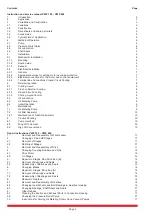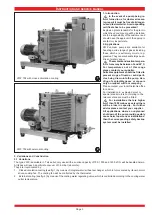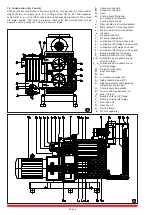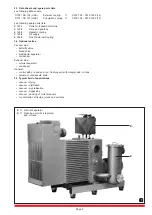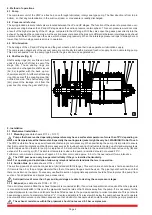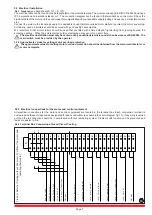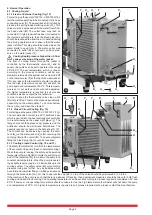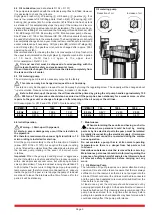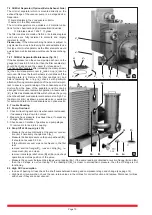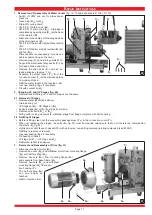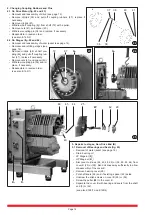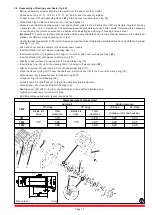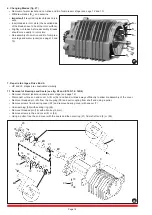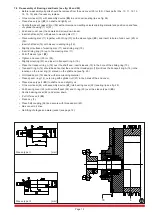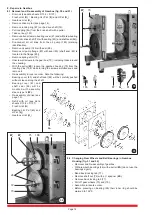
Page 8
U
1
T
Y
4
U
3
U
5
U
4
U
51
U
25
C
Y
41
Y
5
K
4
D
V
4
U
U
26
H
4
I
4
K
4
R
1
Y
5
K
41
U
2
R
Y
41
Y
4
6. Normal Operation
6.1 Cooling Liquid
6.1.1 Fresh or External Cooling (fig. 12)
For starting-up the pump (VWZ 702 - VWZ 1202 (14))
first the water supply has to be connected to the hose
connection point (C). The water jacket (Y
4
) is filled by
pressing the spring loaded priming valve (U
4
). This
valve must be depressed until the water flows from
the hose outlet (D). The outlet hose may then be
connected. If rigid pipework has been connected to
the inlet and outlet points, then the bleed plug (U
25
)
should be loosened to allow the air to escape during
the priming operation and to ensure that the water
jacket is filled. This plug should be closed when the
water starts to seep from it. The water outlet pipe
connected to outlet (D) should exert no back pres-
sure on the water jacket (Y
4
).
Cooling liquid pressure higher than 0.3 bar
causes cracking of the water jacket.
The flow of cooling water through the jacket is
controlled by the thermostatic valve (U
3
) and its
sensor (U
31
) which can be set to operate in the range
50°C-90°C. The set temperature, which is chosen
according to the process conditions, will be con-
stantly maintained by the system and can be read off
on the thermometer (T) at the top of the water jacket.
If for any reason the temperature should rise above
this, the high temperature cut-out (U
1
) will shut the
pump down at a temperature of 90°C. This tempera-
ture is set in our works and should not be adjusted.
If a higher temperature is required to suit process
conditions please contact the manufacturer.
In order to keep the thermostatic valve clean a dirt
filter (U
3
) is fitted. This must be cleaned periodically,
depending on the water quality. To do this unscrew
the nut (U
51
) and clean the element.
6.1.2 Closed Circuit Cooling (fig. 13)
For starting-up the pump (VWZ 702 - VWZ 1202 (13)):
The recommended coolant is a 50% antifreeze mix
which is poured into the heat exchanger at point (H
4
)
to a level midway up the upper sight glass (I
4
). The
filling should not take place under pressure and the
antifreeze should be well mixed beforehand. The
quantity required is shown on the data sheet D 137.
The coolant can be drained by opening the drain
cock (K
4
) on the water jacket (Y
4
) after removing the
vent plug (K
41
) at the cooler (R). To ensure complete
filling the bleed plug (U
26
) should be loosened.
6.1.3 Cooling Liquid Control (fig. 12 and 13)
The safety thermostat (U
1
) controls the temperature
of the coolant at the pump (fresh or external cooling).
When the pump is running, the safety- and operating
temperature thermostat (U) controls the switching on
and off the radial fan (R
1
) to maintain the pump at a
constant set temperature. When the pump is operat-
ing a slight pressure (approx. 0,3 bar) builds up in the
cooling system. The safety valve (H
4
) prevents this
pressure rising any further. Any air bubbles which
have formed during first filling or re-filling can escape
through the bleed valve (U
2
). For this to operate the cap (U
21
) on top of the valve should be unscrewed 2 to 3 turns.
If the location of the pump is such that there is a danger of freezing, then appropriate measures should be taken for both fresh
cooling and closed circuit cooling. The operating temperature can be set at according to process requirements between 50° and
80°C. If however, the operating temperature should continue to rise, the high temperature thermostat will shut down the pump
at a temperature of 90°C. If a higher temperature is required to suit process requirements, please contact the manufacturer.
U
21
U
2
12
Y
42
13


